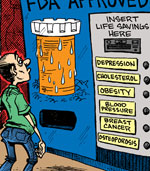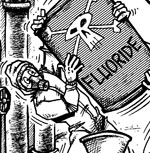Three Things Everyone Needs to Know about Pyridoxine HCl
| Share on Facebook | Share on Twitter | Share on Google+ |
What is pyridoxine hydrochloride? Pyridoxine is the form of vitamin B6 made by plants, especially in the germ of wheat, rice, and corn. Pyridoxine hydrochloride, also known as pyridoxine HCl, is a dry, white powder that can be used to make vitamin B supplements that last an especially long time as you store them on the shelf.
Almost everyone gets enough B6 to avoid deficiency symptoms such as chapped lips, swollen eyelids, and sleepiness, but not everyone gets enough vitamin B6 for optimum recovery from disease. Here are three things everyone needs to know about pyridoxine hydrochloride uses in supplements to fight disease and keep you healthy.
1. Pyridoxine hydrochloride formulas almost always include other B vitamins.
Unless you are taking a medication that depletes vitamin B6 and doesn't deplete other B vitamins (such as penicillamine or Isoniazid), you should take a "complete B" formula. That is because B vitamins work together. Here are some examples:
- Your body can compensate for a niacin deficiency with pyridoxine.
- The regulation of homocysteine, an inflammatory substance associated with heart disease and Alzheimer's, depends on at least pyridoxine (B6), niacin (B3), and cobalamine (B12).
- People who have low levels of B6 are at greater risk of heart disease, but rates of heart disease don't go down unless they receive both B6 and folic acid.
2. People who eat "all natural" have a hard time getting enough pyridoxine.
The minimum B6 needed to avoid deficiency is about 1.7 milligrams a day in older adults. You can get that from three servings of fortified cereals and/or white bread. However, to get that much vitamin B6 from non-fortified food, you would need to eat:
- 10 oz (280 grams) of light-meal chicken (cooked), or
- 11 oz (308 grams) of cooked salmon, or
- 4 bananas, or
- 2-1/2 baked potatoes, with skin, or
- 1 pound of raw spinach
Because most people do eat lots of highly processed cereals and bread, vitamin B6 is deficiency is rare-unless you are doing the right thing by eating all-natural!
3. Getting more B6 than the minimum can support recovery from an astonishing range of diseases.
As you can discover elsewhere on this site, B6 supplementation can be helpful in acne/rosacea, autism, attention deficit disorder and attention deficit-hyperactivity disorder (ADHD), rheumatoid arthritis, allergies, depression, high homocysteine, heart disease, elevated lipid levels, immune depression, morning sickness, depression associated with pregnancy, depression associated with oral contraceptive use, premenstrual syndrome and premenstrual dysphoric disorder, menopause symptoms, age-related cognitive decline and memory loss that is not caused by Alzheimer's, muscle cramps, chapped lips, conjunctivitis, bladder infections, high blood pressure, water retention, diabetic kidney disease, asthma, carpal tunnel syndrome, canker sores (aphthous ulcers), many forms of schizophrenia, vertigo,and overweight. But what about pyroxidine hydrochloride side effects?
If you take the recommended dosage, there aren't any.
The Linus Pauling Institute at the University of Oregon states that a few people who took 1,000 mg of pyridoxine HCl a day developed sensory neuropathy, a condition of burning, stinging, and numbness, in the hands and feet. That is the basis for the United States FDA's upper limit of 100 mg a day, to provide a 10-fold margin of safety. The governments of Australia and New Zealand set 50 mg a day as an absolute upper limit, and the UK and EU, 10 mg a day. But this is enough to do you a lot of good, especially if you are taking medications that deplete B6.
-
Skin CareMen Skin Care
-
Free ResourcesFree eBooks
-
The important thing is this: to be able, at any moment, to sacrifice what we are for what we could become.Maharishi Mahesh Yogi
-
Featured Health SupplementYou will find highly beneficial ingredients in Total Balance
 which are quite rare in other supplements either due to cost, or the need to protect them via enteric coating. Such as L-Glutathione, Resveratrol, RNA, ATP…and many more.
which are quite rare in other supplements either due to cost, or the need to protect them via enteric coating. Such as L-Glutathione, Resveratrol, RNA, ATP…and many more.
-



















